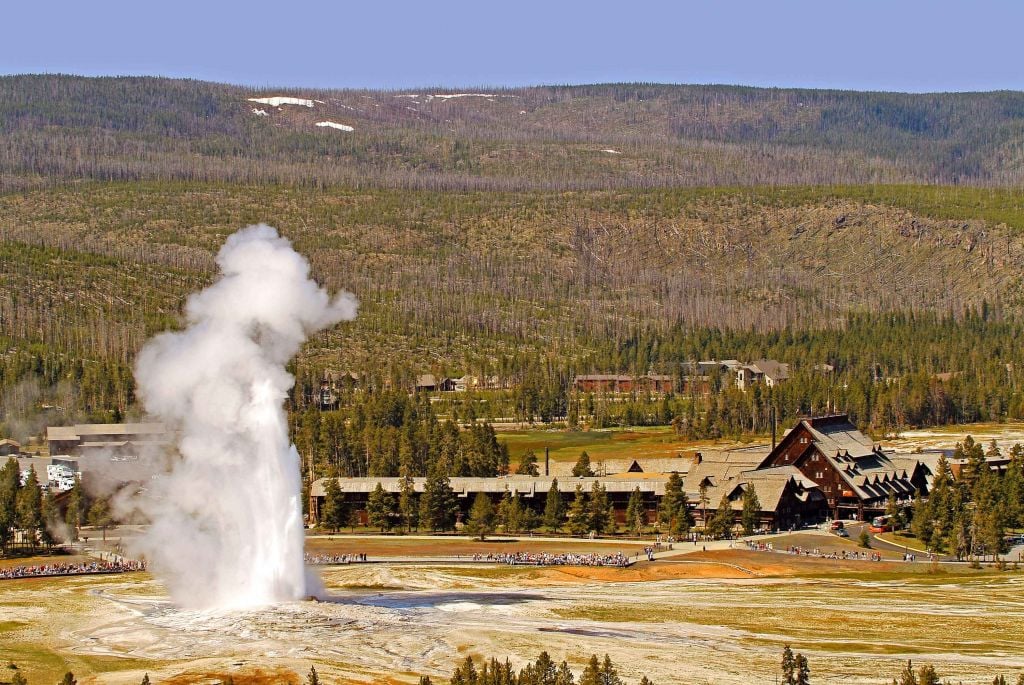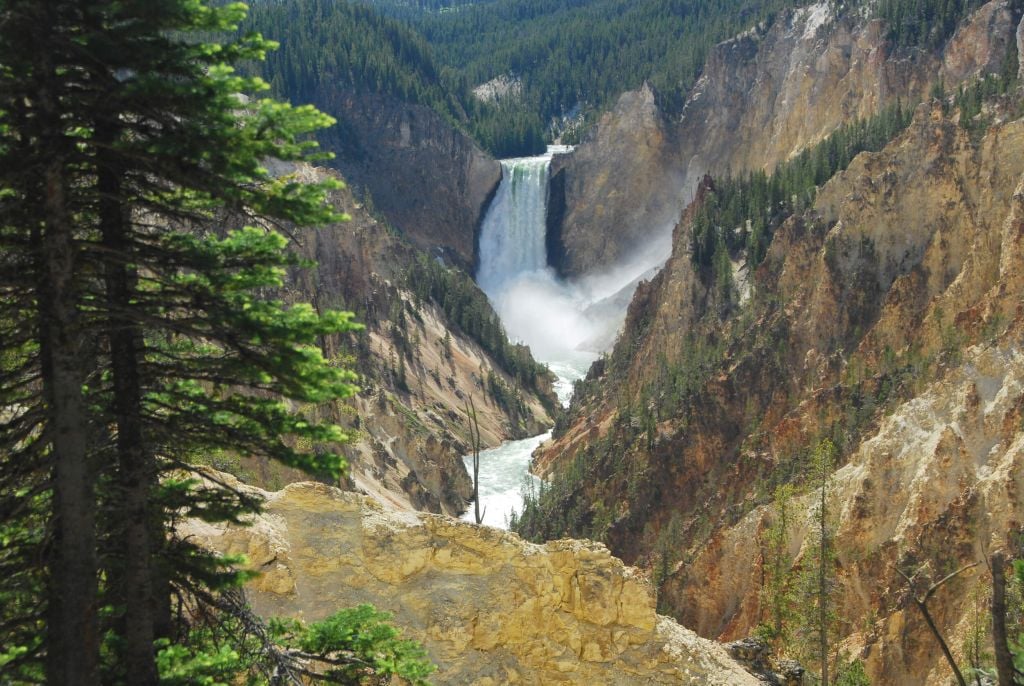Interagency Access Pass
Yellowstone in 2 Days Itinerary
2 Days in Yellowstone
Yellowstone National Park is huge. It’s home to a wide range of ecosystems and remarkable landscapes that are as varied as they are awe-inspiring. From rolling hills dotted with bison to steaming geysers shooting high in the sky, the world’s first national park is an extraordinarily unique place full of natural wonders. And it’s impossible to see in only two days. You could spend a week here and not see everything. But you CAN hit the main highlights in a couple of days! Start early and stay out late – you don’t want to miss a thing. Here are some of our favorite things to see in Yellowstone during a short visit.
Day 1: THE GEYSER BASINS
OLD FAITHFUL
The best way to see the top hot spots is to start early – very early. And your best chance to get an early start is by staying right inside the park. Enjoy a refreshing night’s stay at Old Faithful Inn, the most famous structure in the National Parks. The iconic building is credited for inspiring the rustic architecture often found in national parks and is known for its steeply pitched, gabled, cedar-shingled roof.

From the Inn, head out to the Old Faithful Geyser Basin. The world’s most famous geyser predictably erupts about 20 times a day. It’s an average of 90 minutes between eruptions, but intervals can range from 60 to 110 minutes. Check the Inn’s front desk or the Visitor Center for predicted eruption times before you head out.
UPPER GEYSER BASIN
Come back to the Inn for a late breakfast before heading out to see the rest of the area. While Old Faithful is the star of the show, it certainly isn’t the only one. From here, stroll the rest of the Upper Geyser Basin, where you’ll find at least 150 geysers packed into one square mile, the largest number of these hydrothermal phenomena found in the park. Highlights include the predictable geysers (Castle, Daisy, Grand, and Riverside), the Lion group, 150-foot Beehive, and bright Beauty and Chromatic Pools.

MIDWAY GEYSER BASIN
A short drive north brings you to the Midway Geyser Basin, home of the Grand Prismatic Spring, one of the world’s largest, deepest hot springs. It’s larger than a football field (370 feet in diameter), deeper than a 10-story building (121 feet), is renowned for its size, and its captivating jewel-toned hues. To access Grand Prismatic, walk across the Firehole River (bridge) and along the short boardwalk that snakes through the thermal area where you’ll also see Excelsior Geyser, an enormous geyser crater, Turquoise Pool, and Opal Pool. The colors will be the most vivid when the sun’s high in the sky, but this is also the time with the most visitors. If you want a different perspective (and sometimes a less crowded option), take the Overlook Trail from the Fairy Falls parking lot.

View from the Grand Prismatic from the Overlook Trail (Fairy Falls)
LOWER GEYSER BASIN
Take Firehole Lake Drive past Great Fountain Geyser to the geothermal features of the Lower Geyser Basin—all four types: fumaroles, hot springs, geysers, and mud pots. The loop will take you by the deep blue Celestine Spring, a lively collection of geysers, the impressive Fountain Geyser, a popular attraction in the basin because of it’s size, the bubbling Fountain Paint Pots mud springs.

Bison and visitors at Fountain Paint Pots
NORRIS GEYSER BASIN
The hottest geyser basin in Yellowstone. The tallest geyser in the world. Steaming pools, milky mineral deposits, and mesmerizing shades of blue, green, and gold. Hissing fumaroles and murky mud pots. And the geothermal features of Norris are always changing, making this one of the most dynamic, intriguing places in the park.
Take the half-mile boardwalk trail to Porcelain Basin, taking in Constant Geyser and enormous fumaroles along the way. Another 1.5-mile walk will take you to Back Basin and the sparkling Emerald Spring, the rare acidic Echinus Geyser, and the 300-foot-plus Steamboat Geyser, the tallest in the world. But don’t wait around too long for an eruption; Steamboat does not share Old Faithful’s predictability, and eruption cycles have been measured in years, not minutes.
Next, drive up to Mammoth Hot Springs and dine at the Mammoth Hotel Dining Room to cap off a perfect day of exploration and discovery.
*Wildlife note: Elk, bison, coyotes, and other animals roam freely around the Upper Geyser Basin and other areas of the park. Always be on the lookout!
DAY 2: MAMMOTH TO THE GRAND CANYON OF YELLOWSTONE
MAMMOTH HOT SPRINGS
Rise and shine early, grab a delicious breakfast, and you might have a front-row seat of grazing elk and bison from the windows of the Mammoth Hotel Dining Room, the only 4-star certified green restaurant in the national parks. Once you’re all fueled up, it’s on to Mammoth Hot Spring Terraces. If you’re thinking, wait a minute, we saw all kinds of geysers and hot springs yesterday, not to worry! At the terraces, you’ll find a different kind of thermal feature than you’ve seen elsewhere in the park. The hot springs at Mammoth don’t erupt. They build spectacular travertine terrace formations which have been described as a cave turned inside out. The area consists of boardwalks for up-close viewing of the hot springs and terraces.
The Lower Terrace boardwalk is where you’ll find one of the best-known features, Liberty Cap, rising 37 feet in the air, and Minerva Spring, favored for its wide range of colors and intricate travertine formations. Once you’ve had your fill of the Lower Terrace, make your way to the Upper Terrace Drive. This section is home to Prospect Terrace, New Highland Terrace, Orange Spring Mound, Bath Lake, White Elephant Back Terrace, and Angel Terrace. The Mammoth boardwalks cover an easy 1.75 miles that take about an hour.
THE GRAND CANYON OF YELLOWSTONE
The Grand Canyon of Yellowstone is, simply put, the most breathtaking sight in Yellowstone Park. Head south via the highest road in the park at 8,859 feet, Dunraven Pass. On the drive enjoy the view of 10,243-foot Mt. Washburn and stop at Tower Fall overlook. For even better views and more wildlife spotting opportunities, hike the 6.2-mile (round-trip) trail from the Dunraven Pass trailhead to the summit of Mt. Washburn. Be on the lookout for bighorn sheep. In July, the slopes are covered in wildflowers. Once at the top, it’s nothing but panoramic views—about 20 to 50 miles—all around. And it’s incredible.

Lower Falls of the Grand Canyon of the Yellowstone
Then it’s on to the big show: the dramatic and impressive Grand Canyon of Yellowstone. Twenty miles long, up to 4,000 feet wide, and 1,200 feet deep in some spots. Beautiful pastel yellow, pink, and orange canyon walls. Absolutely magnificent views. And three incredible waterfalls where the Yellowstone River encounters the canyon and its magnificent gorge: Upper Falls, Lower Falls, and Crystal Falls. Drive to each of the several overlooks, via the north or south rim drives, or make use of the trails to explore and appreciate this incredible area. Each spot offers different views of the falls and the canyon, so don’t just stop at one!
Park at Artist Point for inspiring views of the Lower Falls, the tallest waterfall in Yellowstone (308 feet, more than twice the height of Niagara Falls), and its 109-foot counterpart, Upper Falls. You can also get up close on the platform at the Brink of the Upper Falls or the platform at the Brink of the Lower Falls. Other picture-perfect vacation photo backdrops include Artist Point, Lookout Point, and Red Rock Point. There is no shortage of inspiring views.
While not as well-known or dramatic as Upper and Lower Falls, Crystal Falls is certainly no less pretty. From the brink of the Upper Falls, take the short trail to see where Crystal Creek plunges into the canyon. See it from a different perspective from the Brink of Lower Falls trail.
After you’re done at the canyon, end on a high note with a casual dinner at the new mid-century modern Canyon Lodge Eatery. Settle for some bites to share, try a pint of local microbrew, or toast with a glass of wine. We’re sure you’ll have lots to talk about.
Remember, it can take more time than you expect to get from place to place, so plan accordingly. But above all, be patient, flexible, and have fun. And enjoy the unexpected sights along the way—there are lots of them!
Explore Adventures
- Explore Adventures